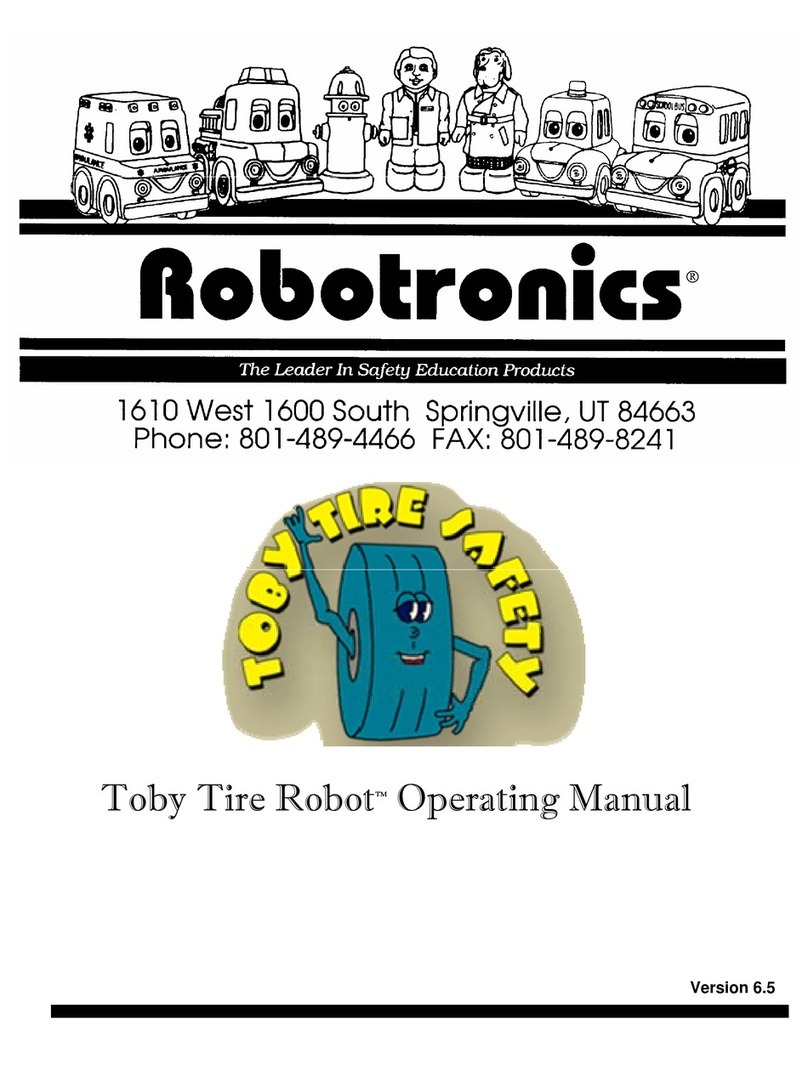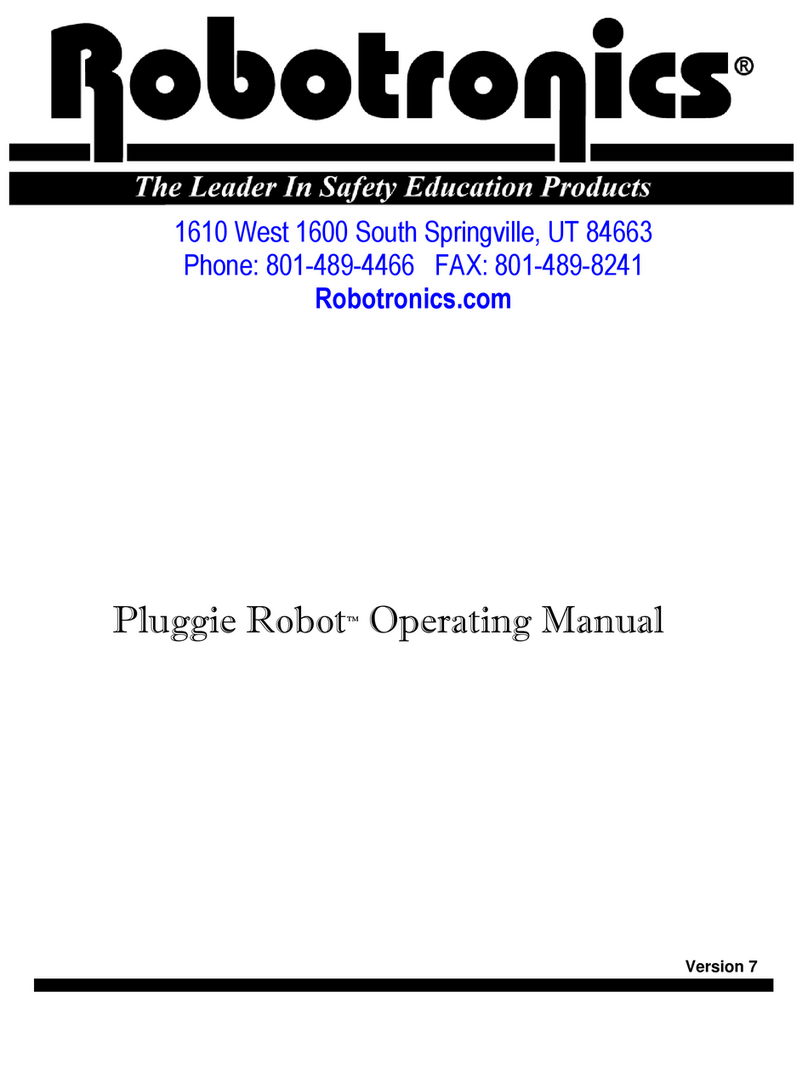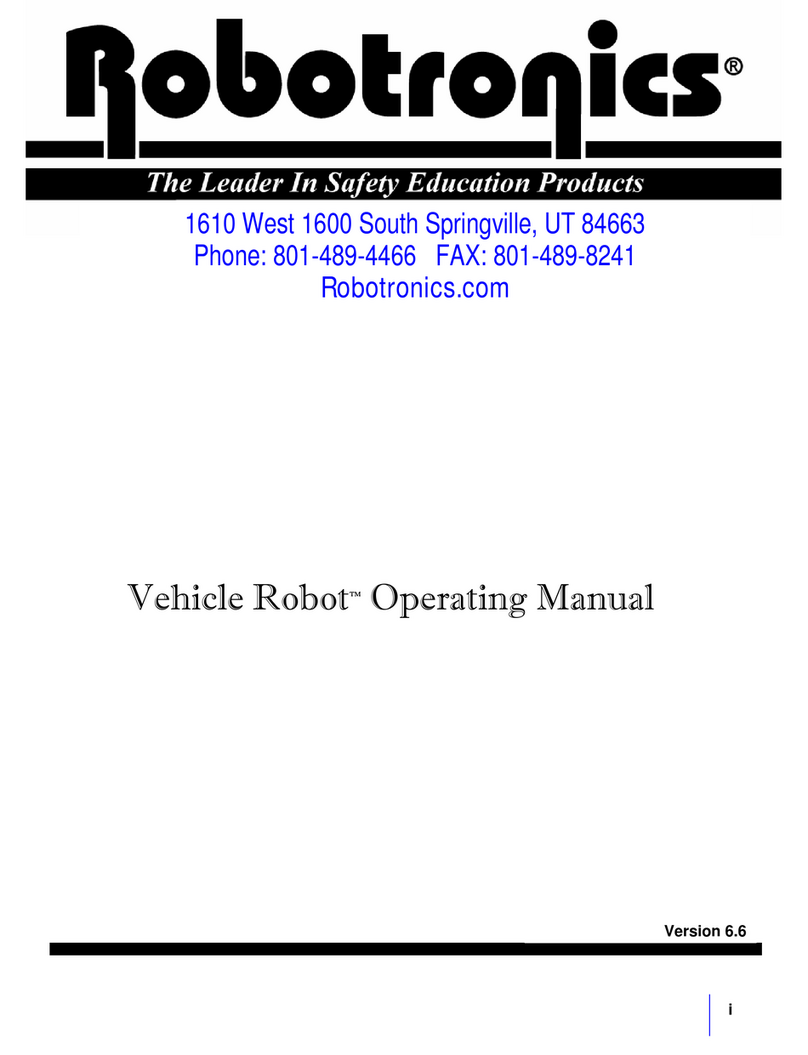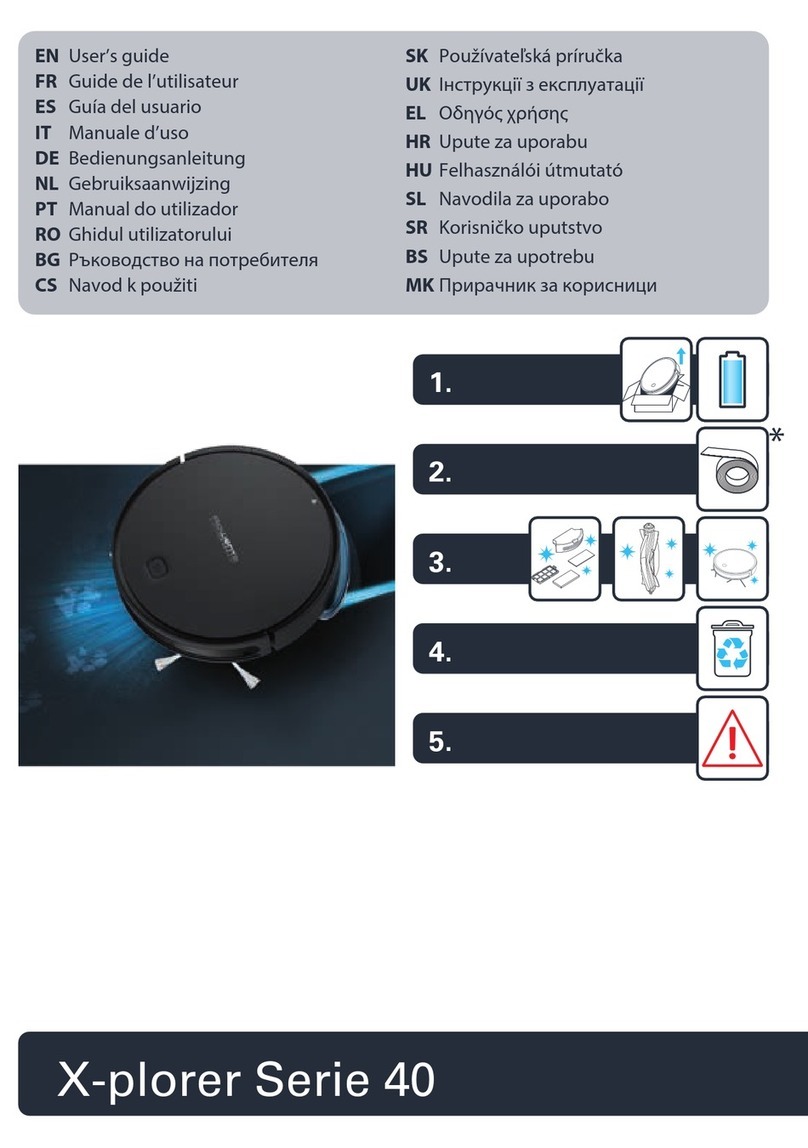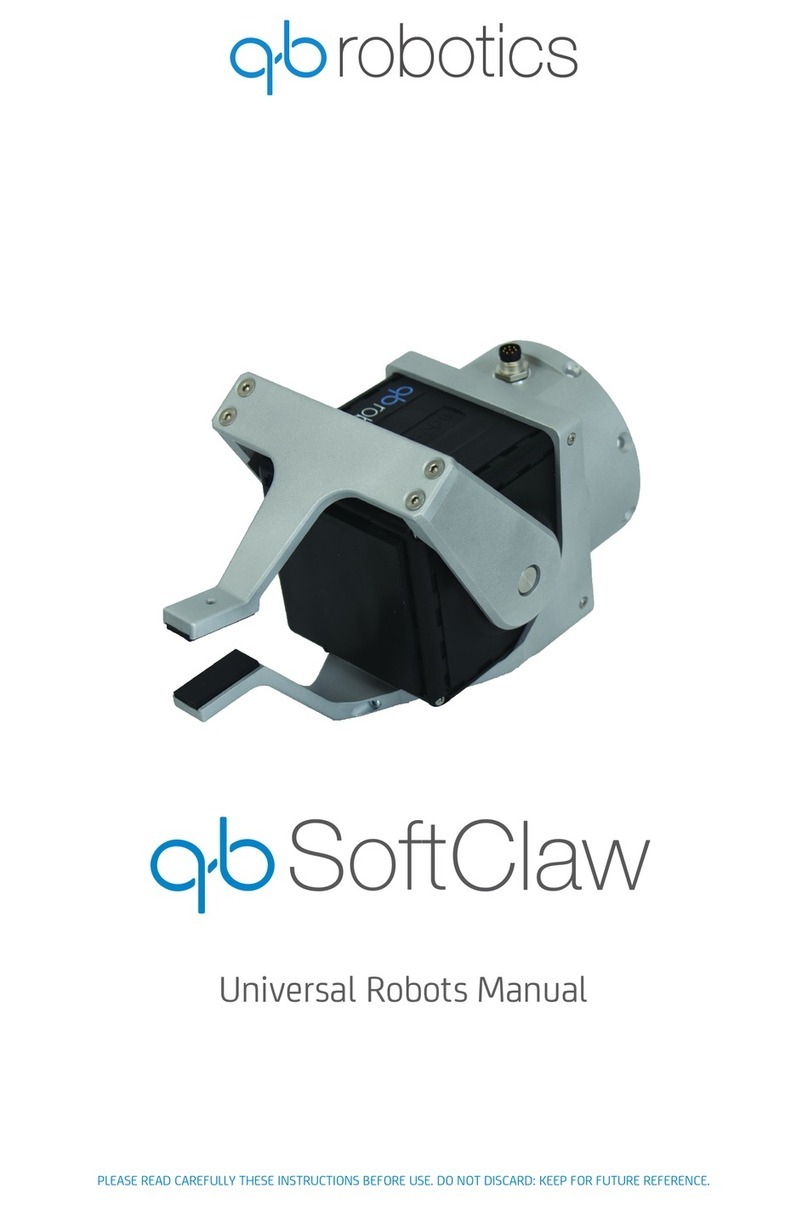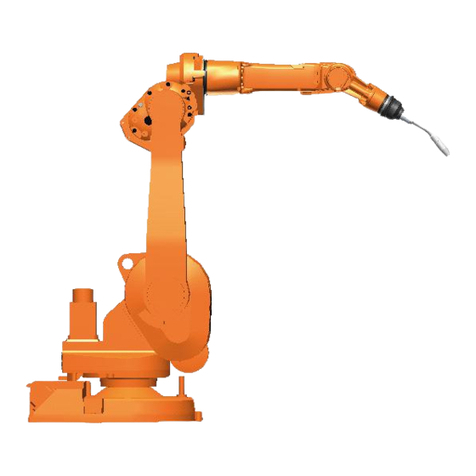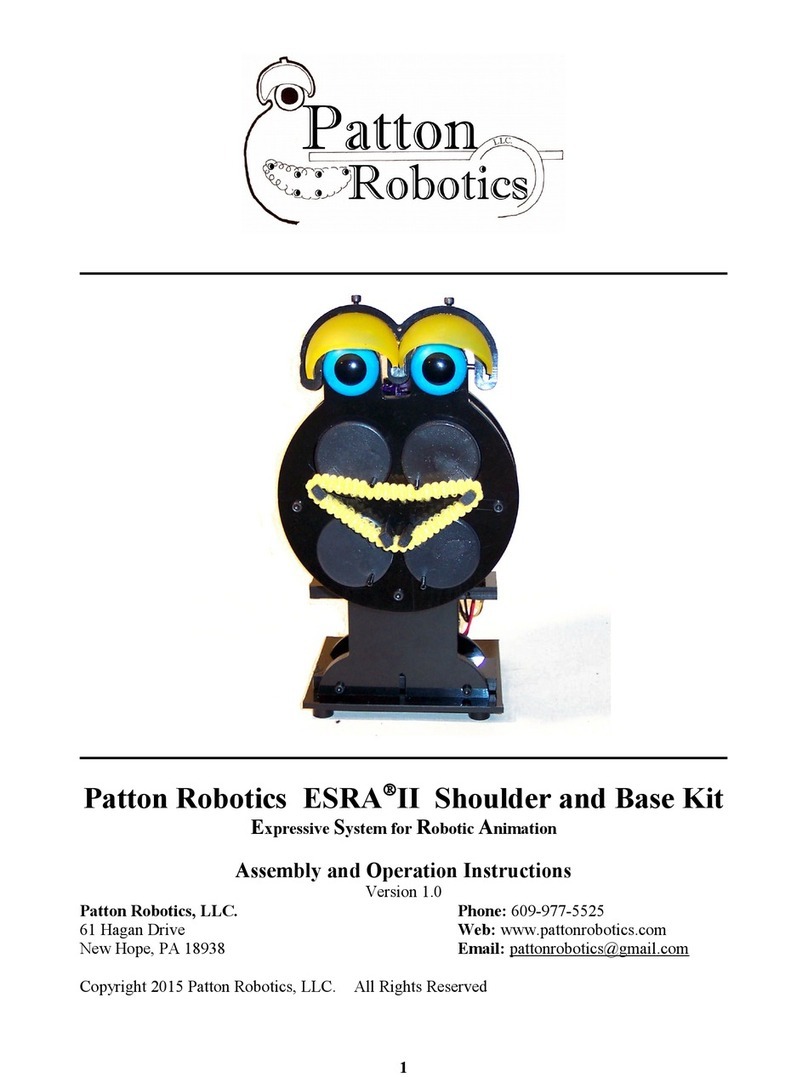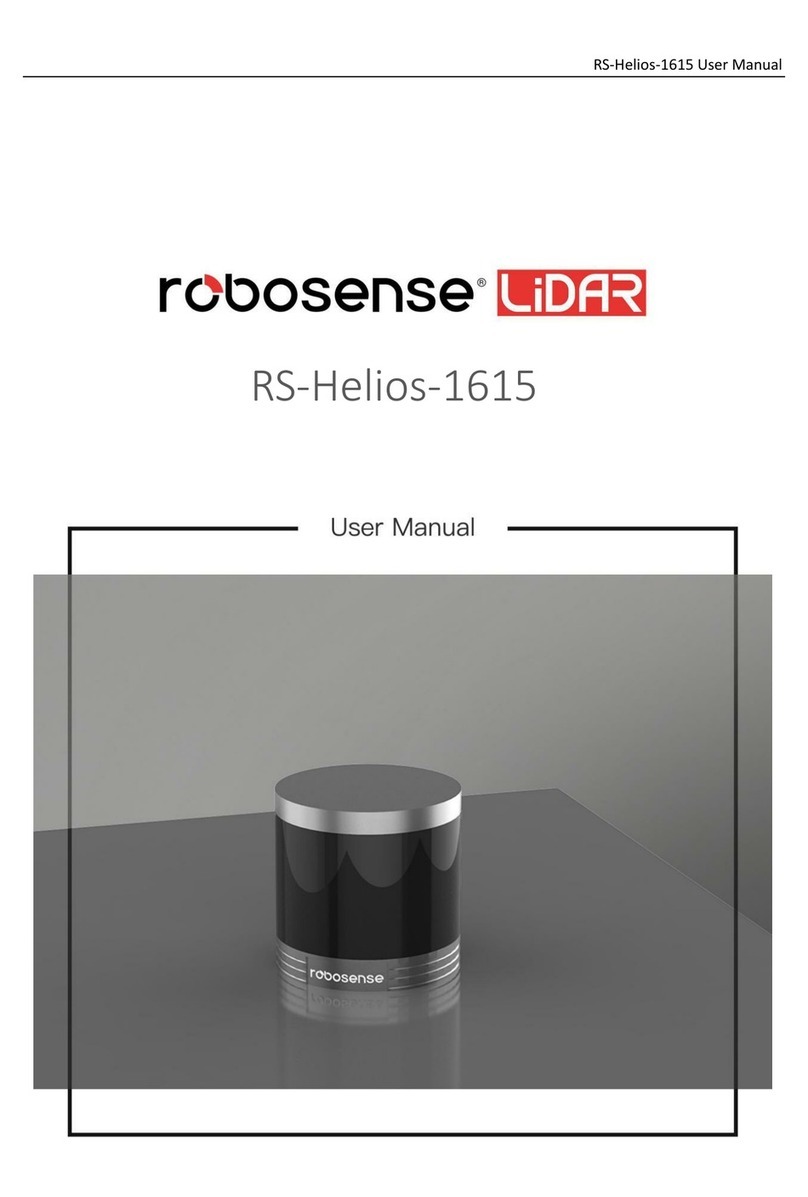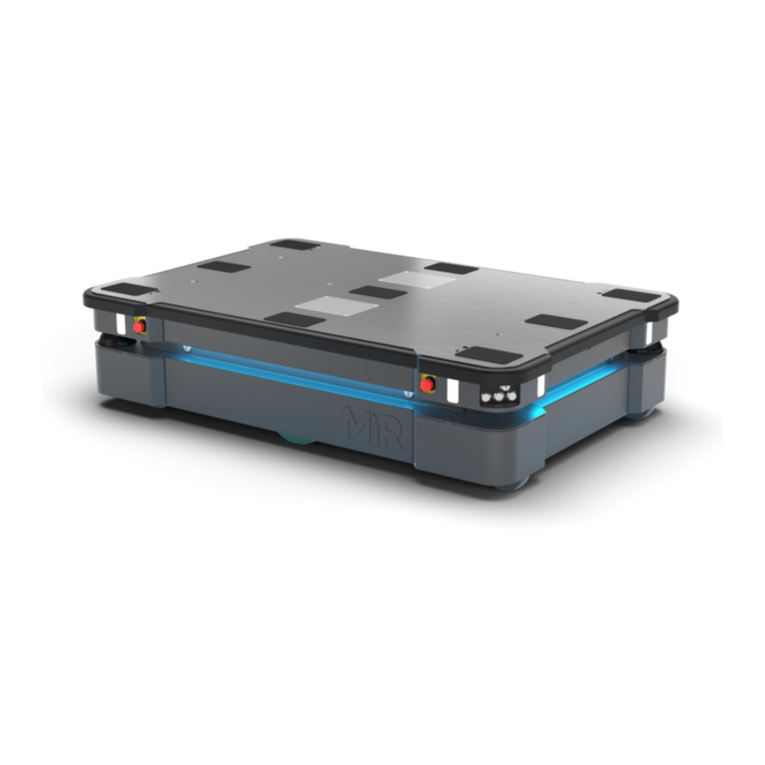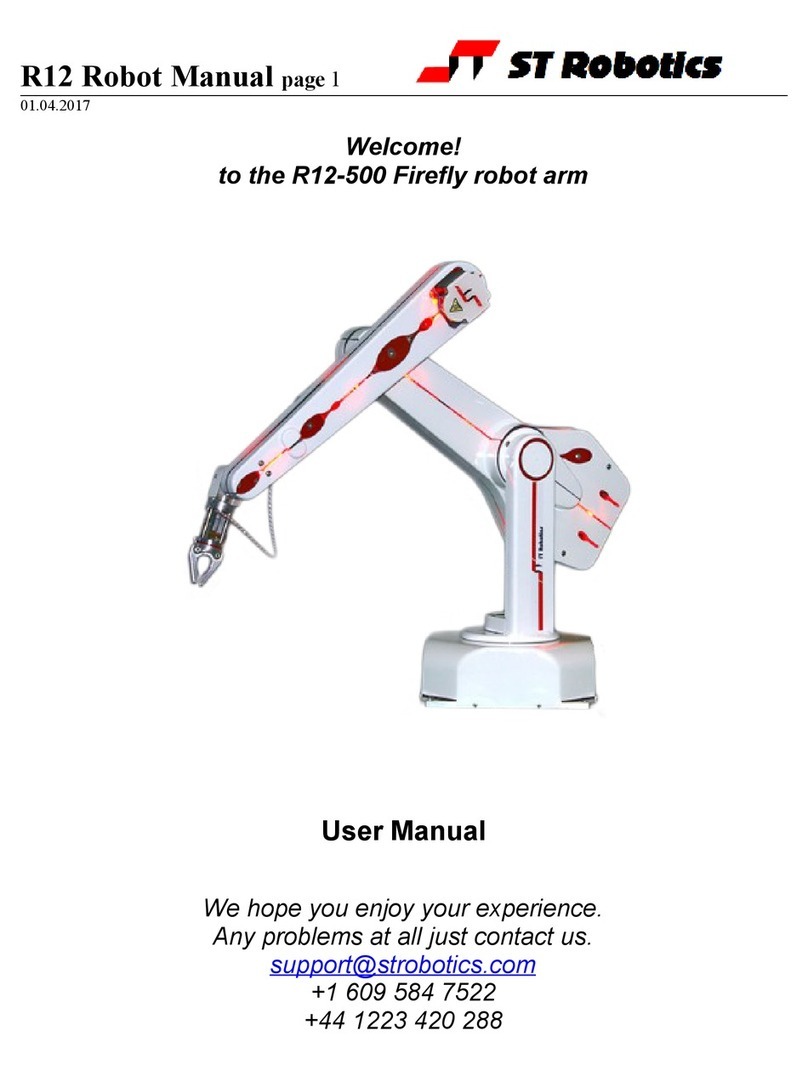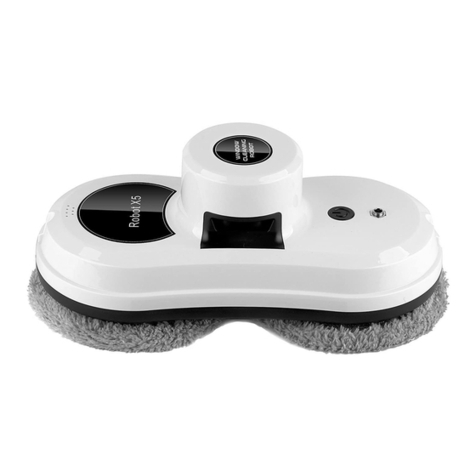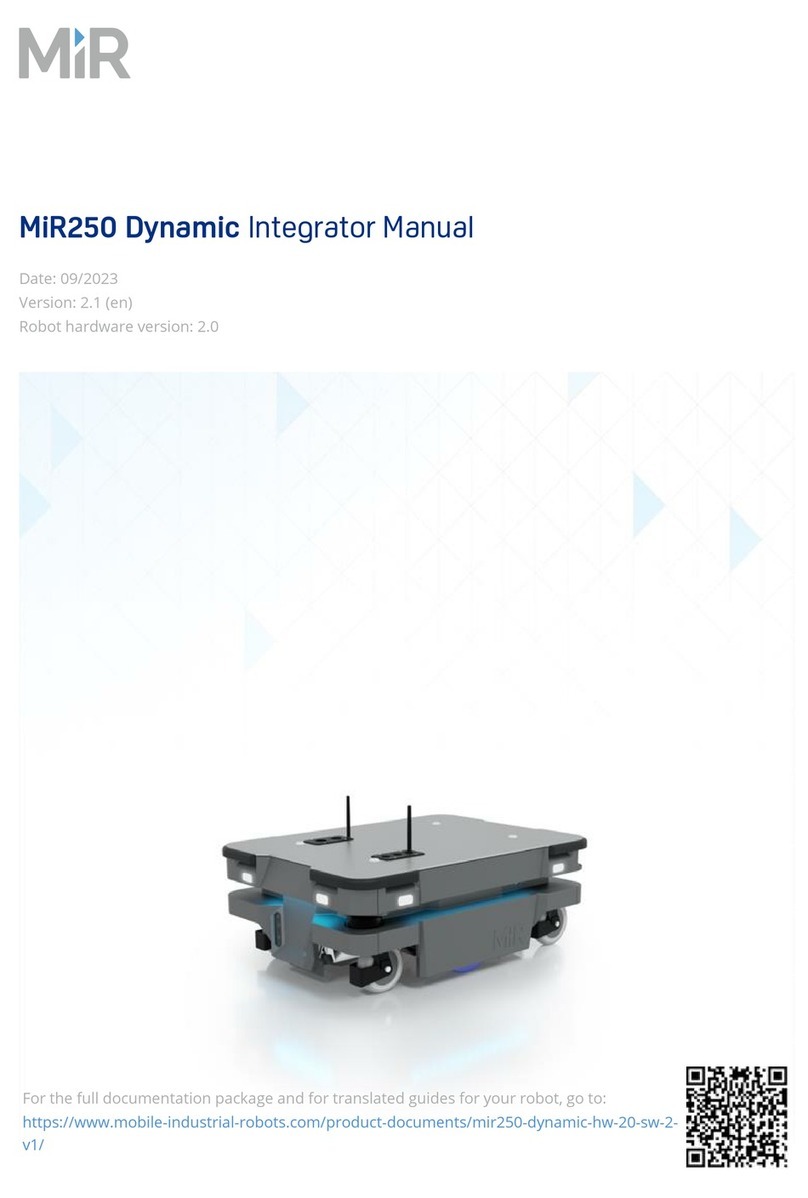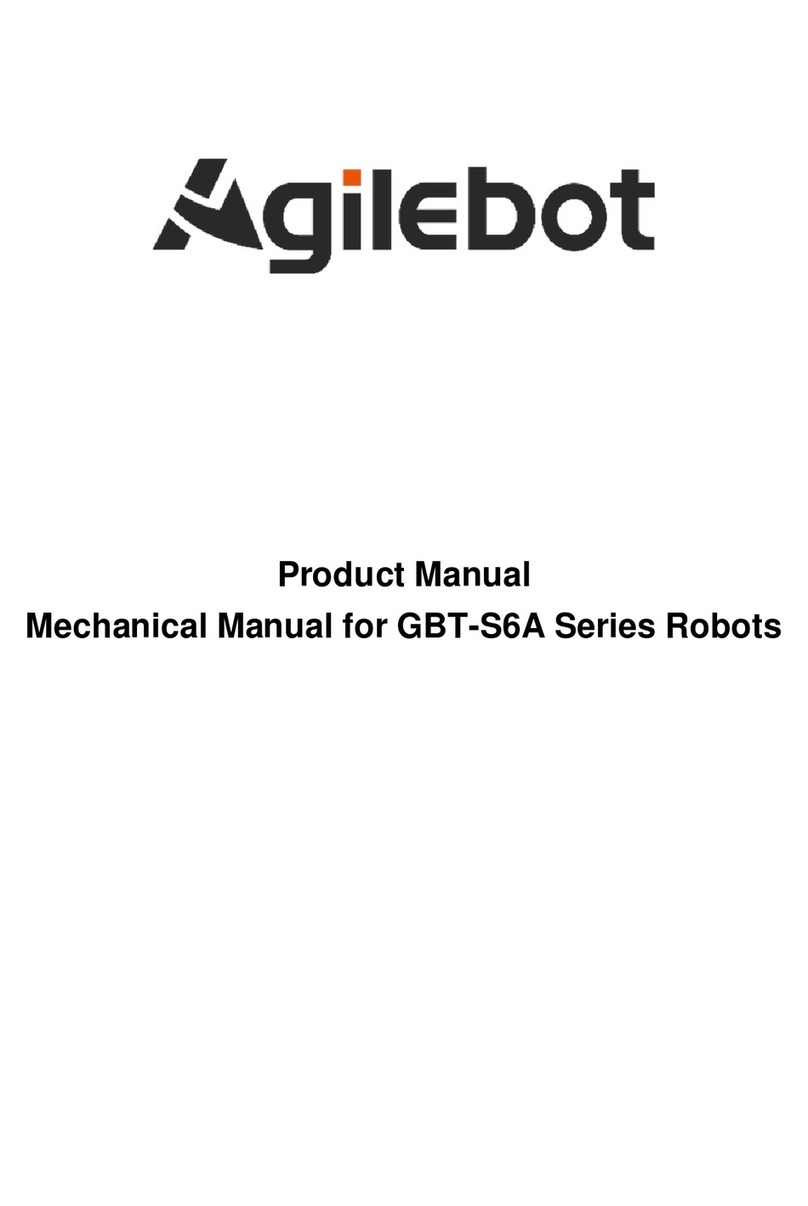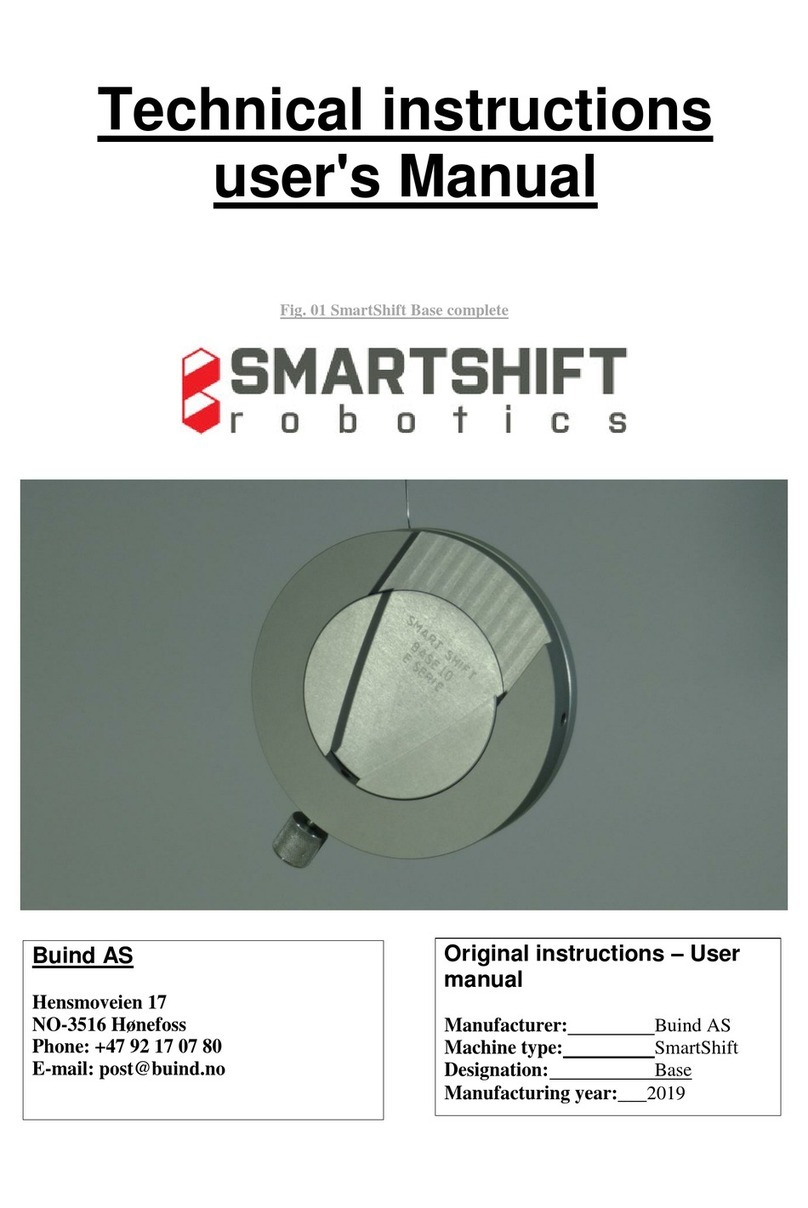Robotronics Patches & Pumper User manual

i
Patches & Pumper™Robot
Operating Manual
Ve
r
s
i
o
n
6C
®

ii
Patches & Pumper™Robot
Congratulations on your purchase of a ROBOTRONICS, Inc.
robot. Your robot has been carefully constructed of the highest quality
components. Its design is the result of years of experience building robots.
You will find it an extremely effective spokesman for your organization. It is
built for ease of operation, maintenance and repair. It is built so that you can
easily expand its functions making its usefulness grow as your needs grow.
Please read this manual carefully. It will help you make the most of your
robot. Attention to maintenance will greatly prolong the life of your robot.
Most problems you encounter will be minor and the manual will provide an
answer. Please feel free to contact us if you have unanswered questions relating
to operation, maintenance, and repair. Also, if you have technical questions
relating to expanding the functions of your robot, we would be most happy to
help.
Sincerely,
ROBOTRONICS, Inc.

iii
Contents
Contents
Warranty Information.......................................................................................... 1
PART 1 General Operating Instructions..................................... 3
Chapter 1 Getting Started...........................................................3
Operating Hints ......................................................................................... 3
Setup and How To Operate The Robot..................................................... 4
Transporting The Robot ............................................................................ 6
PART 2 Subsystems of the Robot.................................................. 7
Chapter 2 Radio Control System ...............................................7
Radio Control Operating Instructions........................................................ 8
Radio Control Transmitter (Diagram)........................................................ 9
Radio Control Transmitter Controls......................................................... 10
Nickel Metal Hydride (NI-MH) R.C. Transmitter Battery.......................... 12
Charging Adapter and 110 Volt Power Supply Option............................ 13
Chapter 3 Voice System Overview ..........................................14
Location of Voice Units............................................................................ 14
Belt Transmitter....................................................................................... 15
Robot Receiver........................................................................................ 16
151 System (Robot TX and Belt 151 Receiver) ...................................... 17
Voice System Troubleshooting................................................................ 18
Mouth Operation..................................................................................... 20
Operator’s Voice Headset, Transmitter, and Receiver............................ 21
Chapter 4 Cassette Tape Player System.................................22
Cassette Tape Player Instructions & Diagrams....................................... 23
Chapter 5 Siren..........................................................................25
Chapter 6 Robot Battery Systems ...........................................26
Pumper Robot Battery............................................................................. 26
Pumper Robot Battery Charger............................................................... 27
Chapter 7 Drive Motor System.................................................29
Chapter 8 Patches Head Turning Motor System ....................31
Chapter 9 Eyelids and Eyes Left and Right.............................32
Chapter 10 Optional Accessories
Water Squirter System......................................................................... 33
Pitch Shifter (Voice Modifier)............................................................... 34

iv Contents
PART 3 Assembly & Disassembly...........................................35
PART 4 Maintenance........................................................................... 36
Chapter 11 Maintenance ...........................................................37
Regular Maintenance Checklist .............................................................. 37
Care of Patches’ Fur............................................................................... 39
Painting of the Body................................................................................ 40
Repair of the Body .................................................................................. 41
Storage.................................................................................................... 42
Appendixes
Appendix A...................................................................................43
QUICK REFERENCE TROUBLESHOOTING ................................. 44
Robot Circuit Block Diagram (Non-Removable Patches)........................ 47
Appendix B Robot Parts Identification....................................48
Lower Robot - Top View.......................................................................... 49
Lower Robot Bottom View-Motor Pulley Set Screws .............................. 50
Main Electronics Box .............................................................................. 51
Pumper Main Electronics Board.............................................................. 52
Pumper Fuse Block Detail....................................................................... 53
Patches Head-Inside View...................................................................... 54
Eyes Servo Board ................................................................................... 55
Upper Robot Bottom View....................................................................... 56
Patches Control Board............................................................................ 57
Notes Section*.................................................................................................... 58
Technical Tips Section* ...................................................................................... 59
* These sections can be used to place additional notes that you would like to record, during
your use of the robot and information sent from Robotronics; such as the technical tips
section of the newsletter.

1
Warranty Information and Getting Help
LIMITED WARRANTY
All robots and accessories have a limited 180 day warranty which covers all parts
and labor. This period covers the normal burn-in for electronic components. Experience
has shown that this warranty period catches most component defects and other possible
flaws.
If you have a problem, we are anxious to help. Our desire is to be certain you receive a
quality product and excellent service.
Warranty work is specifically limited to correction of defects by repair or replacement
of faulty equipment or parts. The robot shall be repaired or replaced at Seller's option.
Equipment returned to the factory for repair must have pre-authorization from our service
department and must be sent freight pre-paid, and will be returned freight pre-paid by UPS
ground or common carrier.
For international shipments, you will be responsible for paying customs duties, taxes
and other fees. The shipment must be labeled on the paperwork and on the outside of the
container that it is “For Educational Purposes”. If it is a “warranty replacement” or a
“repair return” this also must be indicated both ways on the customs documentation.
Contact your customs agency on how to document the shipment correctly to avoid
unnecessary customs charges. If you need parts sent by air shipment you will be
responsible to pay the additional shipping charges.
In no event shall ROBOTRONICS, Inc. be liable for any incidental or consequential
damages in connection with or arising from the use of the robot.
If You Have A Problem
1. Call our service department and explain the problem. The phone number is (801)
489-4466. Most difficulties are minor and can be solved easily over the phone. If
possible, have the robot near the phone when you call.
Important: Have the robot serial number and model number ready. This will help our
technician identify the model of robot you have. The serial and model number sticker is
located on the robot frame on the right side. In the Appendix, the Lower Robot - Top View
shows the location of the serial number sticker.
2. If you must return a part or the robot for repair, pack it carefully and send it prepaid
according to instructions. You must obtain a return authorization number from the
service department before shipping the robot or a part to the factory.
3. Parts of the robot are best sent by a carrier such as UPS, or U.S. mail, because
shipping is based on the actual weight of the package. Be sure to insure the
shipment for the correct value. A freight company such as Yellow Freight , ABF or
Consolidated Freight way should be used only for the complete robot , because their
shipping charges are based on 100 pound minimums.
4. For international shipments, you will be responsible for paying customs duties, taxes
and other fees. The shipment must be labeled on the paperwork and on the outside
of the container that it is “For Educational Purposes”. If it is a “warranty

2 Warranty Information and Getting Help
replacement” or a “repair return” this also must be indicated both ways on the
customs documentation. Contact your customs agency on how to document the
shipment correctly to avoid unnecessary customs charges.
After The Warranty Repair and Help
Our technical staff is always available to help with your questions. Again, most
problems are easily solved. If you do need replacement parts, we can usually ship them the
following day you call. Please call our service department for a return authorization number
before sending a part or your robot in for repair or modifications.
The staff of ROBOTRONICS has taken due care in preparing this manual. Because
of parts availability, robots may vary slightly from unit to unit. If you have any questions,
please contact our service department. The service department phone number is: (801)
489-4466.
The buyer is further responsible to ensure that proper and complete training be given
to those operating the robot system as all aspects of such operation cannot be covered in a
brief manual such as this.
In no event shall ROBOTRONICS, Inc. be liable for any incidental or consequential
damages in connection with or arising from the use of this manual or any procedures
contained herein.

3
Chapter 1 Getting Started: Operating Hints
Part 1 General Operating Instructions
CHAPTER 1 Getting Started
OPERATING HINTS
ROBOTRONICS, Inc. robots are a unique and exciting tool in the hands of a skilled
and trained operator. Much of the excitement the robot conveys is provided by the operator.
The selection and training of the operator should be done carefully, so as to provide a
person with good judgment and an outgoing personality. The operator is the single most
important feature that the robot has. Nevertheless, with a little practice anyone can learn to
operate the robot and even those with a shy personality can be very effective using the
robot.
When operating the robot, always maintain charged batteries and never operate the
robot out of line-of-sight.
When operating in crowds, always have a trained person posted near the robot to
help in crowd control, and to protect the robot from vandalism. This person is also available
to answer questions and interact with the robot.
Operating distance should never exceed 100 feet. When moving the robot through
crowds, the robot should be operated slowly and smoothly without any sudden changes of
direction. Walls, turns, and other obstacles are hazards to be avoided. Safe clearance
should be maintained between these obstacles and the robot. The robot should not be
operated near stairs. When operating on a stage you should leave plenty of distance
between the robot and the edge of the stage and should keep the area below the stage
clear of anyone.
Never leave the robot "ON" when unattended or in direct sunlight for extended
periods of time.
The robot is designed to be operated on hard, smooth surfaces and carpet. Avoid
extra deep shag carpet, dirt, gravel, or grass surfaces. Avoid steep inclines or large uneven
surfaces such as curbs, gutters, or uncovered electrical lines.
Never operate the robot with low batteries in the transmitter, the voice system, or in
the robot itself.
The robot can be a highly successful tool for humor and entertainment. Appropriate
jokes, stories and general conversation can be very effective. Children of all ages are
strongly attracted to the robot. They will talk to it, hug it, kiss it, and generally treat it as a
good friend. The smaller sized robots are most effective with children. They are light in
weight and just the right size to communicate with children. Their light weight plastic
construction makes them extremely safe even around the smallest child.
The most important ingredient to the use and effective operation of the robot is
common sense. The following instructions will help you set up the robot and start using it.

4 Chapter 1 Getting Started: Setup and How to Operate the Robot
SETUP AND HOW TO OPERATE THE ROBOT
Step # 1 Read the manual
Read and study this manual completely before operating the robot.
Step # 2 Charge and install the batteries
Be certain that the robot battery and radio control transmitter battery are fully charged before
operating the robot. Install the robot battery as follows:
Installing the robot battery:
1. Position the battery so that the posts face the rear of the robot. In this position, the
battery wire will naturally run to the robot battery connector.
2. Connect the robot battery connector to the robot connector. Red will go to red and black
to black. This connection is polarity protected and can be connected only the correct
way.
3. Secure the battery in place with the battery strap. Adjust the clip on the strap if
necessary so that when you put the two clips together, the strap is holding the battery in
place tight.
!CAUTION
The robot battery posts should never contact the metal of the main electronics box or
the metal of the drive base. This will result in damage to electronic components
especially inside the main electronics box.
Step # 3 Install the upper robot on the lower
1. Set the upper robot on the lower robot body.
2. Locate the four body latches and push the pins into the body to secure the upper robot
to the lower. Two of the latches are located in the compartment where Patches sits.
The pins are to the left and right of Patches. The other two are at the back of the robot.
To latch these you will need to reach in through the back hatch/trunk.
3. Connect the 37 pin connector which is a round connector and wire bundle running from
the upper robot to the lower robot. When connecting this rotate it until it sits down into
its mate connection and turn the ring until it is secure.
!CAUTION
Before operating the robot or transporting the robot on the cart or in a vehicle; the
upper robot must be properly latched to the lower by pushing the latch pins in.
Failure to do this could cause damage to the upper robot if it fell off.
Step # 4 Voice System Set Up
Put 9-Volt batteries in the voice units (Eveready Alkaline fit tighter). Make sure you follow
the polarity sticker. Put the units on opposite sides of your waist. Plug the headset into the
units. On the 151 Receiver the plug goes into the headphones jack. Adjust the voice
system volume control to the level you want. The voice speaking volume adjustment is
inside the trunk on the voice receiver. The hearing volume level is adjusted on the 151
Receiver that you wear. The Nady 331 Receiver in the robot should have the antenna
extended all the way out.

5
Chapter 1 Getting Started: Setup and How to Operate the Robot
Step # 5 Tape Player Set Up
Put a cassette tape in and press play. The tape player volume can be changed on the tape
player itself, which can be accessed through the rear hatch/trunk.
Step # 6 Powering up
Turn the Radio Control (RC) “ON" first and then turn the robot "ON". Check that the RC
battery level meter reads to the right. Extend the RC antenna about halfway out. The
"ON/OFF" switch for the robot is located inside the trunk on the main electronics panel.
Push the switch left to turn the robot on (On/Off positions are labeled).
Step # 7 Test all the functions
Test all of the robot's functions: The voice both ways, head turning, mouth, steering wheel,
eyelids, eyes, tape, siren, lights, and drive movement for proper operation.
The robot is now ready to operate.
Step # 8 Powering Down
1. Turn off the voice equipment on your belt.
2. Turn the robot power switch to the "OFF" position.
3. Turn off the RC unit.
Step # 9 Charge the batteries again
Connect the Pumper battery to the charger and bring it back to a full charge before leaving
the robot. This battery should not be left with a partial charge. The transmitter battery
should be charged if it is low.
NOTE: The smooth and efficient operation of the robot will come with just a few short hours
of practice. When attempting to operate the robot for the first time, do so in a large flat area
without obstacles. The operation of the controls should be done in a smooth, fluid manner.
Avoid jerking starts and stops or overreacting to the controls. When first practicing
movement, it is sometimes helpful to follow behind the robot as robot movement will match
stick movement. (Controls respond opposite when the robot is facing the operator.)

6 Chapter 1 Getting Started: Transporting the Robot
TRANSPORTING THE ROBOT
Before transporting the robot, remove the robot battery from the robot. The vehicle
that you use to transport the robot should have adequate shock absorption. Vans and cars
used for passengers would be the best. Transporting the robot in a trailer is not
recommended because trailers typically do not have the same level of shock absorption as
a car or van. A good rule of thumb to follow is that if the vehicle is adequate for transporting
a computer, it should also be fine for the robot.
Double check that the upper robot is latched and secure. There are four latches that
must be latched to secure the upper robot to the lower robot (See the diagram below).
These pins must be pushed in to secure the upper robot.
To strap the robot on the cart, roll the robot on to the cart with the back wheels first.
The back wheels will drop in to the recesses. Pull the S-hooks on the cart up to each of the
four eye hooks under the front and back bumpers of the robot.
You can leave the robot on the transport cart while the robot is in transit, to keep the
robot from rolling around. Have the robot cover on the robot to keep the body from getting
scratched.
!CAUTION
If the upper robot is not properly latched before transport, it could come off while
moving the robot with the transport cart or in a vehicle, causing damage to the upper
robot.
Rear Body Latches
Body LatchBody Latch

7
Part 2 Subsystems of the Robot
Part 2 Subsystems of the Robot
Functionally, the robot is made up of the following basic subsystems:
A. Radio Control System (Control)
B. Voice System and Moving Mouth (Audio)
C. Cassette Tape Player (Audio)
D. Siren (Audio)
E. Robot Battery Systems
F. Drive Motors
G. Eyelids and Eyes Left and Right
H. Head Turning
The systems block diagram found in the Appendix, shows how the various
subsystems and their components are interrelated.
Following are explanations of each subsystem, some operating instructions, and
trouble shooting hints where appropriate.
CHAPTER 2 Radio Control System
The Radio Control System consists of the control transmitter unit held by the
operator and the receiver with its associated components in the robot.
The Radio Control Transmitter converts movements of the control sticks and
switches into a coded radio signal which is transmitted by radio to the Radio Control
Receiver within the robot. The signal is received and then decoded by the microcontroller
which is on the main circuit board. The micro-controller controls functions based on what
was sent from the radio control transmitter.
Refer to the diagram showing the radio control transmitter for the location of controls.
Extend the Radio Control Transmitter Antenna 1/4 to 1/2 way. Turn the Radio Control
Transmitter on first and then turn on the main robot power switch. Turn on the robot. It is
necessary for the robot to always have an operating signal when it is on. If there is no signal
you will not have full control of the robot.

8 Chapter 2 Radio Control System
RADIO CONTROL OPERATING INSTRUCTIONS
Refer to the diagram showing the radio control transmitter for the location of controls.
Check all of the trim adjustments on the transmitter and make sure they are in their center
position. Extend the Radio Control Transmitter Antenna 1/4 to 1/2 way. Turn the Radio
Control Transmitter on and then turn on the main robot power switch. It is okay to turn off
the RC with the robot on if the RC battery goes low or if the robot starts moving. This will
put the robot in neutral while your going to the robot to turn it off.
The right hand joystick controls movement of the robot's drive wheels. Pushing the
stick forward will cause the robot to move forward. Pulling the stick back will cause the robot
to move backward. Moving the stick to the right or left will cause the robot to turn to the right
or left respectively. Movement is fully proportional so any variation or combination of
movement is possible. The horizontal and vertical trim tabs to the left and below the joystick
are for centering and should be adjusted if the robot creeps on its own, otherwise they
should be left in the center.
The left joystick left and right moves the eye pupils and the head. The eyes will look
in the direction that you move the head automatically. The slider control below the stick
should be left in the center so that the eyes and head stay in the center. Forward and back
movement of the joystick does not control a function.
For a detail of other functions, see the radio control diagram on the next page. All of
these functions are labeled on the radio control itself.
There is a recharge jack on the side of the transmitter. The recharge jack is used to
charge the internal Nickel Metal Hydride RC transmitter battery. Connect the NI-MH RC
battery charger to it and charge for 16 hours or overnight. This battery pack will give you 5-
6 hours of operation on a full charge.
Take care not to overcharge the batteries as this will shorten their life span. You can
charge the batteries whenever you want but you should not exceed the 16 hours charge
time especially if the battery level does not show in the red yet.

9
Chapter 2 Radio Control System
RADIO CONTROL TRANSMITTER
(Robbe-Futaba F-14)
1
2
13
12
11
9 8
7
6
5
4
14
Switch bank 1
1 2 3 4
5 6 7 8
Switch bank 2
1 2 3 4
5 6 7 8
3
15
10
To remove back cover,
slide the tabs as shown.

10 Chapter 2 RC Controls
RC TRANSMITTER CONTROLS
(Robbe F-14)
1. Telescopic Transmitter Aerial.
2. Transmitter Battery Voltage Meter (Expand Scale Voltmeter)
3. Right control Stick-
Up and Down – Robot drive motors, forward and reverse.
Right and Left – Robot drive motors steering. Left and right turns.
4. Forward/Reverse Trim lever for right control stick. Normal = Center. Neutrals the
drive motors. If the robot is moving slightly slide this a few clicks until robot stops
moving.
5. Left and right Trim lever for right control stick. Normal = Center. Neutrals the drive
motors. If the robot is moving slightly slide this a few clicks until robot stops moving.
6. On/Off switch
7. Recharge jack. Plug the RC battery charger in here to recharge the internal battery.
The charger light will come on when it is connected.
8. Sliding tabs to remove the back cover. Slide both tabs off and take the back cover
off.
9. Antenna storage.
10. Neck strap connecting hook.
11. Left and right Trim lever for left control stick. Normal = Center. Centers the eye
pupils position.
12. Forward and Reverse Trim lever for the left control stick. Normal = Center. Unused.
13. Left Control Stick
Left and right movement - Head turn and turning of the Eyes left and right
Up and Down – Unused
14. Switch bank 1
5. Back-close Left eyelid momentary / Forward- Water Squirter Option
6. Back- Blink. Close both eyelids momentary / Forward- Beacon momentary (On and Off)
7. Back-close right eyelid momentary / Forward- Siren momentary
8. Back – Sleep(push switch to sleep and push again to wake up).

11
Chapter 2 RC Controls
Special note: The eyelids will also open if you hit any one of the eye switches.
15. Switch bank 2
7. Headlights - Forward On / Back Off
8. Cassette Tape Player - Forward On / Back Off
When the battery level goes in the red, the robot should be turned off and the other battery
connected.
The trim adjustments for the drive joystick can be adjusted if the drive centering comes off
slightly such as if the robot starts moving on its own. If the robot does start moving slowly
on its own, move the slider to the left of the stick or below the stick, slightly until it stops.
The trim adjustments for the left joystick will effect the position of the eye pupils. The one
below the left of the stick effects the position of the pupil (Typically leave in the center).
To remove the back cover of the transmitter
Remove the sliding locks at the bottom of the transmitter. This is all that is necessary to
release the back cover. This will give you access to the RC transmitter battery inside if you
need to replace it.

12 Chapter 2 RC Transmitter Battery
THE Nickel Metal Hydride (NI-MH) RC TRANSMITTER BATTERY
The NI-MH RC transmitter battery will last about 5-6 hours on a full charge. Charge
the battery for 16 hours. A charge jack is provided on the transmitter for recharging its
internal batteries. This round jack is located on the right side of the radio control. (See the
radio control diagram) The RC power switch must be in the off position when the charger is
plugged into it and must remain in the off position while charging. A light on the charger will
be on, when charging.
Caution: Do not overcharge the batteries as this could cause permanent damage to the
transmitter batteries. (Doubling the normal charging time is the type of over charging that is
meant here, and the battery getting hot.) When the battery level needle goes in the red, the
robot should be turned off because the robot could act erratic without the transmitter signal.
To avoid a RC battery going dead during a presentation, start the program with a
fully charged battery or be aware of how much charge there is left in the battery. If you have
an extra battery or the optional 110 Volt RC Power Supply, you can connect one of these
and keep going.
To install the NI-MH battery pack you need to take the back cover off the RC.
To remove back cover,
slide the tabs as shown.
NI-MH RC Battery and Charger Specifications
NI-MH RC transmitter battery 9.6 Volts 1300mAH
NI-MH RC transmitter battery charger 11.6 Volts 130mA
Adapter for Charging an Extra NI-MH RC Transmitter Battery

Chapter 2 Radio Control: Adapter and 110 V Supply
13
If you have an extra NI-MH RC battery, you can charge this outside the RC. You
may want to do this while you are using the robot or if you need to charge both batteries at
the same time. The adapter needed to do this is in the control case or it is on your charger.
It has a white connector on one side and a connection on the other end that will go directly
to your battery. The charging time is still 16 hours.
110 Volt RC Transmitter Power Supply Option
The 110V RC Power Supply is a power unit that plugs into a standard electrical
outlet and in to the RC transmitter. This allows you to have continuous power without using
batteries. This connects into the same connection as the battery. To make the connection
you need to take the back cover off the RC. The wire feeds through a slot in the RC case.
When you re-close the case be sure that the wire is not pinched. With this option, you do
need to stand near an electrical outlet or have an extension cord.

14 Chapter 3 Voice System
CHAPTER 3 Voice System
The Voice System consists of two separate communication links. One link transmits the
operator's voice to the robot. When you speak into the headset mic, this audio goes to a
transmitter on your belt. This audio is transmitted to a receiver in the robot. The audio
signal then goes from the receiver through a mixing circuit on the main board. It is then is
fed into the amplifier which amplifies the signal through the robot's speakers.
The second voice link transmits the audio detected by the Mic element (located in the front
of the robot) to the 151 receiver (which is worn by the operator). This is amplified and sent
to the speaker in the operator's headset.
Important: The operator’s transmitter and receiver should be kept as far separate as
possible, such as on opposite sides of the operator's waist. Do not attach the units together,
this may cause interference effects. The antennas should not be wrapped around each
other or around the headset wire but should hang freely.
Location of Voice Units
Voice Transmitter- Operator wears
Voice Receiver- On the frame in the lower robot.
151 Transmitter- On the frame in the robot. The robot mic connects to it.
151 Receiver- Operator wears
Operator’s Voice Transmitter, Receiver, and Headset
3.5 mm headphones
Plu
g
On some models the mic
plug is a 3 Pin Mini XLR
151 Receiver Transmitter
3.5 mm
mic plug

15
Chapter 3 Voice System
How to Operate the Operator’s Transmitter
1. Open the battery door.
2. Use a 9 volt alkaline battery and insert it according to the diagram inside the battery
compartment.
3. Place the headset on your head and adjust the microphone to approximately 1 inch from
your mouth.
4. Plug the round connector from the headset into the top of the transmitter.
5. Move slide switches to the "ON" position.
6. On the UB-10 there is a volume adjust on the unit.
Function of the LED
When turning on the power switch, with a fresh alkaline 9-volt, the battery light will blink on
momentarily and go out. This indicates that it is powering up and that the battery is good.
Because the light is a low battery indicator, when the light is on constant, this indicates the
battery is too low-below 7 volts. Replace with a new alkaline battery.
Tip: The operator’s voice units both have metal clips that contact the posts of the 9-
volt battery. These must be bent out from time to time to keep this contact good.
18. Battery Compartment
19. 9 V Alkaline Battery
20. Input Selector Switch ( Leave On 3 Lavalier)
21. 3.5 mm jack
25. Off/Standby/On switch
26. Battery Indicator LED
27. Volume- Input Level Control
28. Belt Clip

16 Chapter 3 Voice System
How to Operate the Receiver (in Robot)
There are two adjustments on the receiver. The volume is on the back of the receiver,
which you may set to the desired volume. On the UHF UB-10 you can change the volume
on your belt transmitter on the fly. The other adjustment is the sensitivity. This is factory
preset to maximum sensitivity. This effects how sensitive the receiver is to the transmitter
signal. Typically you would never need to adjust this. The only exception would be if you
get squelch when the transmitter is off. You can deal with this by simply turning on the belt
transmitter whenever the robot is turned on. You could turn the sensitivity down slightly but
turn the adjustment as little as possible, because adjusting it will affect the range.
Function of the LEDs
TX LED- This indicates that you are receiving a signal from the transmitter. On some units it
is a single TX light. On other units it may have an A or B that it will alternate between.
AF LED- This light indicates that audio is going through the receiver. It will flash as you
speak into your headset mic.
Tip: For best range extend the receiver antenna(s) as much as possible, not allowing it
to touch metal.
1. Power On LED Indicator
2. Diversity LED Indicators
3. AF Peak LED Indicator
4. Antennas
5. Power Switch (Leave On)
6. DC Input Jack
7. Frequency Label
8. Squelch Control
9. Aux. Volume Control
10. Audio Output
11 Balanced Mic Audio Output XLR
Table of contents
Other Robotronics Robotics manuals
